How to make site design profitable (part1)
October 22, 2014
Let us first agree who this article is intended for (hereinafter referredto as performer) and what problems you face every day.
freelance designer designer;
working in a web-studio / web-agency;
web-studio / web-agency;
intermediary between the above and the customer.
Meeting
All the above performers face the same issues. I suggest discussing these issues together in this series of articles. Certainly, the start of communication differs. Some go to the customer, wait for the appointment when they can be taken. Then the design of the future brainchild is discussed personally with the owner or with a group of employees. Others get tasks from their managers or idly take the customer in their office and listen how to draw “seven parallel lines”. Still others, lucky ones, sit at home or in a separate office and receive all the tasks by mail or by a call from the customer – via Skype, for example. 
Statement of the problem
Then everybody faces the same task: how to remember everything the customer has said and to remind (or rather persuade) that this is what the customer asked for. Then you should start everything from scratch and do it all over again.
Prototypes
Then you should find what your customer needs. On the one hand,you understand how everything is supposed to look like. You are a designer and know what he wants. You start creating something and think, “Yes, that is what heneeds… he will like it.” You sit down and make several pages at a time. Let us consider the most frequent situation: a designer handsthe layouts over to the project manager, who presents the layout to the customer (in one of the ways above), comes back and says, “We make 100500 corrections in this layout, and the customer wants to see another 2-3 options to choose from”. Of course, the customer was shown your previous works at the meeting, and competitors were discussed. Of course, the customer was opened your favorite sites and a couple of top resources - say, “look here, nobody does itthis way...”.
First layout
However, the result is the same: you should do it over. “He didn't like my design… who knows whathe wants… and he asks for 2-3 options”, the designer thinks angrily. Then he starts looking through tons of samples shown to the customer.
Content
Let’s go on: your customer has already chosen one layout that will not change until the end of the project (it is what you think). Then a question arises: what do you fill 32 site pages with? All right, you have an ingenious idea for the main page. There are 5-7 more pages, let's call them standard: contacts, brief news, detailed news, feedback, documents… and here you've exhausted the list. The customer imagines something between the GAZPROM site with a lot of text, photos and pictures, and the apple.com site (or at least its analogue, vivid, with flourishes). Probably, he was keen on wood engraving at school and imagines the site with flourishes and textin the form of shavings… All right, you've got the idea.
The question is what to fill the site with. Yes, some pages can be stuffed with model content, impressive “foreigners” with a crossed strip. But what will bethen… how will it look like with real content? There appear “pages under development”, pages with two sentences and pages with photos that are shameful to show. But this is your customer, your image, your portfolio. Yes, you can provide him with a text editor in the site admin-panel – say, “fill it as you think it necessary”. Then show in the portfolio what the customer has put there by copy-pasting information from his doc file with the big red letters on the blue background....
Development and control
Now you have a mess with sending layouts to the customer -> demonstration -> discussion -> editing -> and round again. What problems arise? A lot of them! Just at this stage,the real work begins. Just in this period, the customer remembers that he wanted something else in this project. Or, probably, he imagined many things in a different way than you (project manager) or your designer. The customer maybe at work or may be on a business trip with only his phone available. The customer is often busy and forgets what you showed to him a week before, which layouts have already approved and which have not. Probably, coming back home on Friday evening, he just wanted to review what has been done over the week. We can go on and on.
Completion ofwork
Here everything depends on initial arrangements (50/50, pay as you get, payment in parts, per hour...). However, the result is the same: until the customer sees everything in a way he wants, he will not pay. Not only pay, but pay in time. Then you will get another job from his partners or friends.
In this article, I outlined the main problems arising during site design. In the next part,I will show you how we can tackle them to minimize time spent and maxim profit. Follow the updates.
© Igor Abyzov
Project Manager
